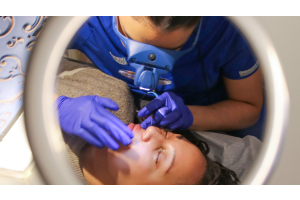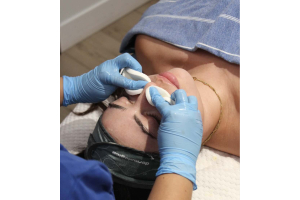Anyone who has experienced unwanted hair growth has at least one thing in common: they want to get rid of that hair! While doing so is often top-of-mind (believe us, we get it!), it can also be helpful to understand what is causing the hair to grow in the first place.
Androgenic Hair Growth Appearance
A common type of unwanted hair is androgenic hair growth in women. Androgenic hair growth typically manifests as an excess of hair in areas associated with male-pattern hair growth, such as facial hair, back hair, chest hair, and hair on the lower stomach. In contrast to light, vellus hair (“peach fuzz”), androgenic hair growth is typically dark and coarse. It is “normal” for cisgender women (women assigned female at birth) to experience vellus hair growth on many areas of the body such as the arms, but those with androgenic hair growth will find that this hair is dark and thick, not light and fuzzy.
Causes of Androgenic Hair Growth
Androgenic hair growth in women is typically caused by a higher-than-normal level of androgens (male hormones), like testosterone and androstenedione. These hormones are secreted by the adrenal glands or ovaries and produced in hair follicles, thus stimulating hair growth. Everyone produces androgens, but people assigned female at birth typically have low levels of these hormones that don’t cause significant terminal hair growth in areas where men tend to have more hair. It is estimated that between 5 and 10 percent of women are affected by androgenic hair growth, and it is more commonly found in women who have family members that experience this type of hair growth as well.
Two common causes of high androgen levels in women are polycystic ovary syndrome (PCOS) and idiopathic hirsutism, which means there often isn’t a detectable cause. Other adrenal gland disorders such as Cushing disease and congenital adrenal hyperplasia may also cause a hormonal imbalance that leads to androgenic hair growth, and it may be a side effect of certain medications as well. Obesity is another condition that increases androgen production which can make androgenic hair growth in women worse.
Treating Androgenic Hair Growth
While the hair itself is treatable, a hormonal imbalance may be the sign of a more serious health disorder, so women assigned female at birth who experience androgenic hair growth should be sure to consult their doctor to rule out any potentially serious health conditions. Even when under hormonal treatment, some or much of the hair tends to stay, with permanent hair removal is the solution for that.
Permanent Androgenic Hair Removal with Electrolysis
While excess hair growth may not bother some women, others may feel self-conscious about their hair growth and seek ways to remove it. Hair removal methods like waxing, threading, etc. are only temporary, and methods like laser hair removal can promise hair reduction, but not permanent removal.
The only method allowed by the FDA to advertise as permanent hair removal is electrolysis because it works for every skin and hair color – even white hair or very tan skin. If you decide electrolysis is the way to go, our electrologists are highly experienced at removing unwanted androgenic hair growth and you can schedule a free consultation to learn more by calling us at 212 863-9058, emailing [email protected] or booking online.






